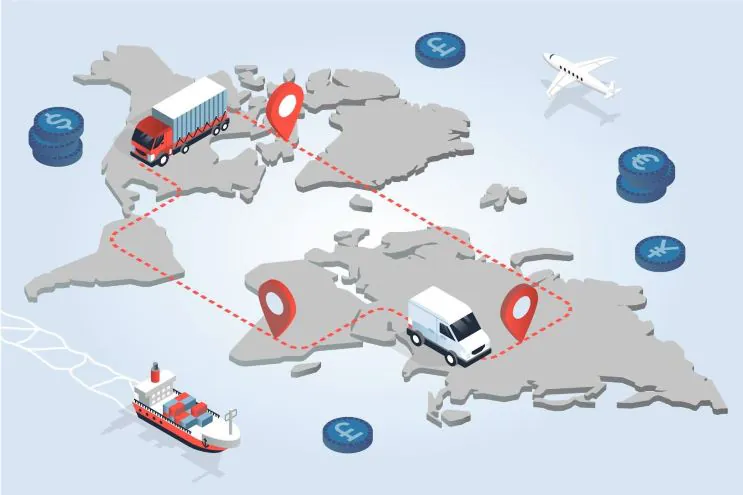Reshoring, nearshoring, friendshoring, onshoring, and offshoring – which to choose?
In our previous article on the varieties of outsourcing, we cited both the importance and some examples of the use of outsourcing by various companies. We hope that you learned something new from it and that it encouraged you to consider implementing one of the process implementation options of your choice. In this article, we will briefly remind you what they consist of and focus more on the cases and conditions in which each approach is likely to work. We invite you to read on!

Source: Freepik
Reshoring
Reshoring is a strategy that means moving production and service provision from abroad to another foreign country or sometimes to the home country. It is for this reason that reshoring is often equated with the boomerang effect. It originated relatively recently, only a dozen years ago in the US, when it was decided to partially move production from China back to the US. An example of a company that uses this strategy is Adidas, which has relocated some of its operations from Asia back to Europe.
Companies opt for reshoring for a variety of reasons. A few of these reasons include: improving the quality of services or products, increasing control over the production process, responding more quickly to market needs, or reducing transportation costs. Reshoring also promotes job creation in the home country. This strategy may be the answer to shielding operations from the uncertainties associated with global supply chains.
Reshoring strengthens relations with local communities and authorities, improving brand image. Returning production to the home country provides greater flexibility in responding to changing regulations and standards. In addition, this outsourcing option increases employee engagement by investing in local communities. Finally, reshoring reduces transportation costs and reliance on global supply chains, increasing operational stability.
Nearshoring
Nearshoring is the approach that applies to the transfer of services and production to countries neighboring or geographically close to the company’s home country. This makes it easier to maintain contacts not only in terms of legal issues but other issues as well. In 2019, Poland was ranked the 2nd largest recipient of foreign investment in Central and Eastern Europe. Nearshoring is definitely common in the IT industry. An example of a company that uses nearshoring is IBM, which moved part of its operations from the US to Mexico.
With this practice, the company usually offers lower costs for production or services provided. The goal of nearshoring is often to retain some of the benefits associated with operating in culturally and linguistically similar countries as well as increase control over the production process. It enables efficient problem-solving compared to other sourcing strategies in today’s list.
Nearshoring makes it possible to maintain close contact with business partners, facilitate rapid communication, and coordinate activities. Culturally and linguistically similar conditions are beneficial, facilitating cooperation and understanding of customer needs. On top of this, nearshoring minimizes the risks associated with long transportation routes, while maintaining lower costs compared to offshoring. It’s a compromise between cost control and quality control.

Source: https://www.nimble.com
Friendshoring
Friendshoring is an approach that deals with a company’s selection of business partners or suppliers on the basis of a personal relationship with them, rather than on the basis of their quality, price, or other important factors. In the case of friendshoring, sharing political, economic, and military values is relevant here when selecting business partners. As a result, friendshoring can lead to insufficient efficiency and competitiveness of the company. An example of a company using this approach is Starbucks, which has located part of its coffee production in Latin American countries.
Unlike the other strategies, friendshoring focuses on the benefits of working with a country with a similar business culture and regulations, rather than the costs. The strategy in question is conducive to increasing exports, as partner countries can be additional markets. The war in Ukraine has contributed to greater interest in friendshoring.
Friendshoring builds long-term relationships based on trust and shared values. This option speeds up problem-solving and facilitates negotiations through strong ties between business partners. It is an attractive option for companies with limited resources and companies that prefer to work with trusted partners instead of looking for new suppliers. However, potential negative effects, such as lack of competitiveness or limited access to new technologies, should be carefully evaluated.
Onshoring
Onshoring is a strategy that involves moving part or all of a business’s operation, such as manufacturing or providing services, back to a company’s home country. It is the opposite of offshoring, where operations are moved overseas. Compared to nearshoring, onshoring focuses on keeping operations in-country, allowing for easier management and control of processes. An example of a company using onshoring is General Motors, which moved production of some car models from overseas factories back to the US.
Onshoring can be an attractive option for companies that want to increase involvement in local communities, support the development of local labor markets, and minimize the risks associated with operating in foreign markets. Moving operations back to the home country can also enable a company to respond more quickly to changing market conditions and maintain high-quality products or services.
Onshoring often stems from a desire for greater control over production and to meet local standards and regulations. Local operations allow for better monitoring of processes and quicker response to problems, which increases efficiency. However, before making a decision, it is important to carefully evaluate the costs and benefits, as well as potential challenges, such as increased labor costs or market competitiveness, to ensure that onshoring is the right strategy for the company.

Source: https://evrotarget.com
Offshoring
Offshoring is the process that involves moving some or all of a business’s operations to other countries to reduce costs or increase efficiency. This strategy is similar to nearshoring, but with offshoring, operations are outsourced to further countries, often with a different time zone. Thus, this strategy makes it possible to reach skilled workers in other regions. An example of a company using offshoring is DHL, which has moved some of its distribution centers and logistics operations to Asian countries.
Offshoring is a popular strategy for many companies, but it can affect employment and the development of local labor markets. A company can move production from a high-cost country to a lower-cost country to reduce the company’s outgoings. This also promotes hedging against unfavorable political and economic conditions. In contrast, cultural and time differences can contribute to relationship difficulties.
Offshoring is a way to reduce operating costs while maintaining high quality. Moving operations to countries with lower labor costs can increase competitiveness by lowering prices. It also helps diversify risk by minimizing dependence on single markets. However, the difficulties of managing remote teams, cultural differences, different taxes, and legal differences must be taken into account.
Summary
The choice of one strategy naturally depends on the individual needs and circumstances of the company. It may be that the choice is dictated by government policies and changes in trade regulations. Regardless of the choice of business strategy regarding the location of production and services, optimizing the cargo carried always remains relevant. It’s worth staying on top of supply chain tools.
We have a load planning program called EasyCargo. In addition to determining both the plan for the optimal distribution of goods (you can group them according to unloading locations) and the axle pressure of the cargo space, it allows you to generate reports in Excel or PDF format. It even lets you make a public link to share with colleagues. Test the app for 10 days for free.
We strive to provide support materials for the program. This being said, you can find many video tutorials and user manuals on our website. In addition, you can integrate EasyCargo with your company’s software or other programs using our API. You can get acquainted with its details using this link.




